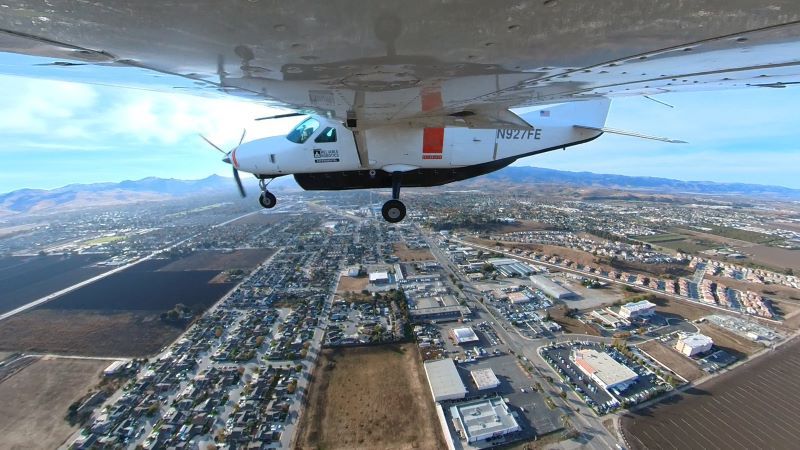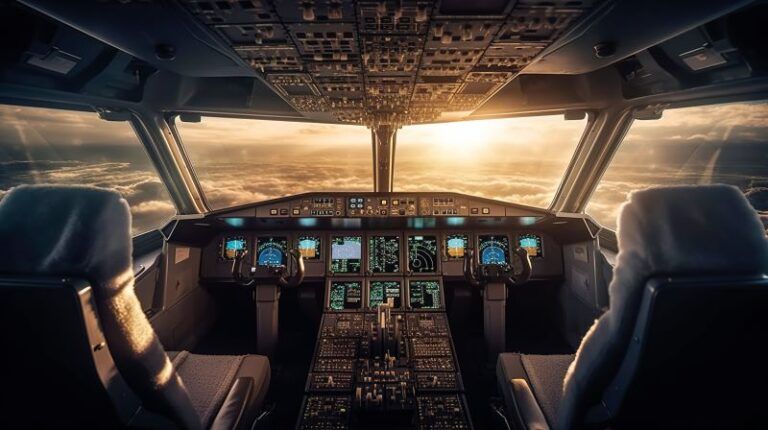The 12 minute flight in civil airspace took place at Hollister Municipal Airport, Northern California. Reliable Robotics, a company founded in 2017, used a control center at its headquarters in Mountain View about 50 miles (80km) away from Hollister to conduct the flight.
The company’s automatic system using fly-by-wire software is installed to move the Caravan’s cable and pulley control system typically found in aircraft certified under FAA Part 23. “So while the underlying cable system is single channel, we are adding on top of that highly redundant and reliable actuation,” says Robert Rose, the CEO and co-founder of Reliable Robotics.
Rose also notes that the Reliable system is designed to reduce two common causes of fatal aviation accidents – controlled-flight-into-terrain (CFIT) and loss of control by a human pilot. National Transportation Safety Board figures from 2021 show that loss of control is the leading cause of fatal accidents in general aviation. Many CFIT accidents also result in fatalities.
Waypoints were loaded remotely into the Reliable automation system for the demo flight. Pilots are accustomed to loading waypoints of a flight plan into a Flight Management System in the cockpit, and the Reliable system also specifies altitudes to be flown along the route.
Scaling up
Reliable Robotics is a Silicon Valley company. You can see Google’s headquarters from the front door of the company’s office in Mountain View. Rose’s credibility is high in the Valley. He was director of flight software for SpaceX, managed the development of the first Tesla automotive autopilot and designed robotics software for Google.
There have been a few conversions in the past of production aircraft to optionally piloted or fully uncrewed. For example, DARPA converted a Black Hawk helicopter for autonomous flight in its Aircrew Labor In-Cockpit Automation System (ALIAS) project with Sikorsky in 2018, eventually flying it without a pilot aboard.

The initial target for Reliable Robotics’s system is not a military aircraft but a civil cargo airplane, the Cessna Caravan, which can carry a payload of up to 3,000 lbs (1,360kg). But the company is aiming for an airframe-agnostic system compatible with conventional flight controls. Airliners with fly-by-wire flight controls may be next on the to do list but present a much bigger challenge.
“The Caravan is a logical first target for us, given that automation is going to make this aircraft much safer than it is today,” says Rose.
Cargo operations
Reliable Robotics is operating five Caravan aircraft as cargo feeders into Fedex hub airports to learn more about the types of cargo operations where automation can help. Contract carriers operate routes where pilots fly as little as one and a half hours a day to carry small loads of cargo from outlying airports to a hub. A lot of these pilots’ time is spent waiting at airports.
The single pilot operations, often at night at lower altitudes than jet airliners use, are challenging and there have been fatalities. The plan is to replace the pilot in the aircraft with an automated system and a remote pilot supervisor. Rose says there are several reasons this makes good business sense.
In June 2023, the FAA formally accepted Reliable Robotics’ Project Specific Certification Plan (PSCP) for an autonomous flight system that enables continuous autopilot engagement through all phases of operations including taxi, take-off and landing.
“Reliable is the only company that has reached this critical point, positioning them as the clear front-runner in the FAA certification process for autonomous aircraft,” says Eric Schulz, a strategic advisor to Reliable.
“The certification milestone represents an extensive independent review of our system,” says Chris Schulenberg, certification program manager at Reliable Robotics in a recent blog post.

The company’s multi-disciplinary engineering effort conducts detailed, highly structured safety assessment activities. The company is using the FAA’s accepted standard SAE ARP 4761A guidelines for conducting a safety assessment process as a guiding document.
The FAA review included the concurrence from 18 designated engineering representatives as well as the involvement of many FAA technical specialists, according to Schulenberg. “The successful acceptance of our PSCP is the result of several submission and feedback cycles and countless weekly meetings and special briefings with the FAA,” he says.
Reliable Robotics still must deliver more detailed planning documents, including System Level Certification Plans to obtain FAA agreement on technical deliverables to substantiate the compliance process in different regulatory domains.
Caravan certification
Since the Caravan is already a certified airframe, Reliable is working to obtain two Part 23 Supplemental Type Certificates (STCs) from the FAA. The first will allow the Reliable system and autopilot to be always on during normal operations. “So an operator gets in the plane and turns the autopilot on and programs it to complete the flight,” says Rose.
This programming can also be done remotely. The STC is for a “normal” category aircraft. Rose notes there is nothing abnormal about it and the Caravan will be certified under existing regulations.
Reliable has a competitor, Xwing. The San Francisco-based company is also working on automating a Caravan. While Reliable is taking the approach of an autopilot on steroids and a remote pilot, Xwing aims to fly a Caravan under remote pilot supervision in cargo service, relying on artificial intelligence and machine learning-based technology to guide the flight.
Reliable is working in parallel with the FAA on a second STC which will cover all of the functions, equipment, and capabilities needed by the Caravan 208 to be remotely piloted and fully integrated into the National Airspace System (NAS).
This STC includes approval of a detect and avoid (DAA) technology, a C2 Link, control station as well as contingency and emergency management procedures. The airborne DAA system includes as sensors ADS-B In, active transponder surveillance, and an air-to-air radar.
Reliable intends to leverage a DAA alerting and guidance algorithm that the FAA is developing called ACAS X (airborne collision avoidance system). The C2 Link system will allow the remote pilot to securely command the aircraft and interact with ATC through onboard VHF radios.

Reliable radar
In October, Reliable hired Marc Pos as a senior fellow to lead its radar design effort. The radar will detect and track all aircraft including ones that are noncooperative through all weather conditions. An airborne radar will have to be designed with reduced size, weight, power and cost for airborne use in commercial Caravan operations.
While air-to-air radars have not been certified by the FAA before, the agency has issued TSO-c212, which contains the requirements that Reliable intends to follow.
Pos has three decades of experience designing radios, radars including phased arrays and radio altimeters. This includes 21 years at Honeywell. He holds 14 patents for radar and radio altimeter innovations. He also led a NASA study on the usability of radar for Beyond Visual Line of Sight (BVLOS) operations.
As part of the first STC process Reliable produced two issue papers for the FAA and in February the agency concluded the definition of requirements for the company’s full flight navigation and automation solutions needed to achieve a means of compliance. The issue paper process is used by the agency when novel systems reveal gaps in current regulations and the need for new ways to assure these systems are safe. According to a post by Schulenberg on LinkedIn, there will be an issue paper on the “means of compliance for Reliable’s novel / proprietary high-integrity navigation system, and another on performance and safety requirements for automatic take-off, -taxi and landing.”
First deployment
Reliable is seeking FAA approval to operate in the 48 states in the Continental United States plus Alaska, but not Hawaii. The company is seeking this authority to operate without any exemptions, special conditions or equivalent level of safety findings from the FAA.
The systems will initially be installed in Reliable’s fleet of five Caravans carrying cargo to Fedex hubs. “The STCs are just part of the equation. We also need to modify the Part 135 operation specifications to allow the operation of this new equipment in civil airspace,” Rose says. “Whenever you put anything new into a Part 135 operation, the FAA digs into it to certify the use of the equipment. Our plan, once we figure that out, is to deploy this to the rest of the fleet and license it out to Caravan operators.”
Textron has delivered more than 3,000 Caravans to customers and Reliable is working with the manufacturer. Chris Hearne, Textron senior vice president of engineering and programs, sees Reliable’s pilotless flight as a milestone.
“Working through current rules enables us and the FAA to move faster and continue to improve the high levels of safety expected in aviation,” says Reliable co-founder and chief technology officer Juerg Frefel.
Danah Tommalieh served as pilot in command of the demo flight. She was the logical choice because she is a commercial pilot and worked as a human factors engineer on the automation system She also played a key role in simulation exercises leading to flying the Caravan without a pilot aboard.
“Our preference is to test as much as we can in simulation because we can iterate faster than with the flight article,” Rose says. “But there are things that you just have to test on the aircraft.”

Simulation
The program has already logged five million hours of simulation. “We are pretty conservative with the amount of time we put on the aircraft,” Rose says. “We set a high bar for what we choose to test on the aircraft.”
It is not possible to test all the environmental conditions the system may experience such as flight control failures, weight and balance configurations and different fuel loadings. In addition there are various density altitudes, crosswinds, headwinds, tailwinds and gusts to account for. It is impractical to hit all those test points in the real world.
“We will probably go into the tens of millions of hours of simulation or higher,” Rose says. “We are still mapping out flight testing but that will likely be many hundreds of hours.”
Reliable has built a high-fidelity digital model of the Caravan that can run thousands of simulations in parallel. Engineers then conduct flight tests to prove that the simulations match the real world. A key simulation goal is to perfect automated landings.
First customers
ASL Aviation Holdings is interested in using Reliable’s automation system for its business in Europe, Asia, Africa and Australia where it operates 160 cargo aircraft in remote areas that are not well served by aviation. ASL’s partnership with Reliable is allowing it to examine how this technology might be used in its operations.
Reliable has also demonstrated its system to the US Air Force and NASA in flight tests. The Air Force wants to see if Reliable’s commercial automation system could be installed on large multi-engine aircraft and used for cargo transportation, air refueling and other missions.
Reliable has been working with AFWERX, the department of the Air Force‘s innovation organization at Wright Patterson Air Force Base, Ohio, under a series of three SBIR contracts since 2021. In January, Reliable received military airworthiness approval from the USAF to begin flight testing and operational missions of its remotely piloted Cessna Caravan. Reliable has conducted detailed analyses of its systems capabilities and confirmed its adaptability to large multi-engine aircraft including the KC-135 Stratotanker.
In February 2023, NASA researchers visited Reliable Robotics headquarters to observe flight testing focused on Reliable’s detect and avoid technology. Brad Snelling, NASA Advanced Air Mobility chief engineer for partner activity participated.
“These landmark flights will help the entire AAM industry understand how future use of primary surveillance radar data could enhance aviation safety,” Snelling says. Data collected for analysis included a feed from FAA primary surveillance radar. A NASA report on the tests will be provided to the FAA.





